Charles Koechlin: Paysages et marines, Op. 63
When French artist Henri Rivière (1864–1951) designed his first set of lithographs, it was for a very specific audience. The 16 pictures that formed Les aspects de la nature (Aspects of Nature) were intended to complement images of France being taught in school. The first printing was a limited edition of 1,000 in large format, intended for home decoration.

Henri Rivière
Rivière grew up in the Pyrenees, where the family had moved while fleeing Paris during the Franco-Prussian War. Being surrounded by nature meant that, later, nature was a large part of his art. Although originally placed at an ostrich-feather importation business, the young artist fled after a week and began painting. A friend of his father’s recognised his talent and started to train him. By 1880, he was creating illustrations for magazines and other periodicals, and eventually returned to Paris, where he became the art editor for the newly created weekly Chat Noir journal (1882–1889).
He became interested in etchings in 1882, further experimenting with colour woodcuts and chromolithography. His first collection, Les aspects de la nature (Aspects of Nature), was issued between 1897 and 1899. His later collections showed his interest in the prints of Japanese woodcut artists such as Hiroshige and Hokusai, when he created his unfinished coloured woodcut series of 36 Views of the Eiffel Tower (issued in 1902 as coloured lithographs).

Henri Rivière: Trente Six Vues de la Tour Eiffel: La Tour en Construction Vue du Trocadero
To return to the Aspects of Nature. This first collection also shows Japanese influences, although not as clearly as does the 36 Views. The images (1/ The Bay, 1897; 2/ Night at Sea, 1897; 3/ The Cliff, 1897; 4/ The Mountain, 1897; 5/ Summer Evening, 1897; 6/ The River, 1897; 7/ The Island, 1898; 8/ The Twilight, 1898; 9/ The Woods; Winter, 1898; 10/ The Rising of the Moon, 1898; 11/ The Sunset, 1898; 12/ The Stream, 1898; 13/ The Forest, 1908; 14/ The Sea, 1908; 15/ The Valley, 1908; and 16/ Cape, 1908) take us from forest to river to the sea. People and animals are present in the images, but it’s the landscape that is important.
The images were printed in 12 colours and continue to be of interest to collectors.
In no. 5 of the series, Soir d’été (Summer Evening), 5 sailboats make their way back home. They have oars out to aid the homeward journey.

Henri Rivière: Les Aspects de la nature: Nr. 5: Soir d’été, 1897
As they pass by the forest on the bank, the light of the setting sun catches the top of the sails of the last boats. On the green bank, goats are foraging one last instant before heading to their own homes. The colours are muted. One very Japanese aspect is the shading of the sky, as the salmon-coloured sunset creeps up from the horizon and replaces the blue sky. The framing of the image through the bent tree-trunk is reminiscent of Hiroshige’s The Residence with Plum Trees at Kameido, 1857, where the plum orchard is seen through a bent branch. This was famously imitated by Van Gogh as Flowering Plum Orchard (after Hiroshige) (1887).

Hiroshige: The Residence with Plum Trees at Kameido (left) and
Van Gogh: Flowering Plum Orchard (after Hiroshige) (right) (Amsterdam: Van Gogh Museum)
Charles Koechlin (1867–1950) was a French composer, teacher, and musicologist. Koechlin was enormously inquisitive and throughout his long life was a fan of ‘medieval music, The Jungle Book of Rudyard Kipling, Johann Sebastian Bach, film stars (especially Lilian Harvey and Ginger Rogers), traveling, stereoscopic photography and socialism’. His Seven Stars Symphony was not about the stars in the sky but the stars on the silvery screen, i.e., film stars.
At the request of his family, he studied engineering but finished with only mediocre standing. Defeating his family’s objections, he entered the Paris Conservatoire in 1890, studying composition with Jules Massenet; in 1896, he studied with Gabriel Fauré, numbering Maurice Ravel and Jean Roger-Ducasse as fellow students. He worked closely with Fauré, orchestrating a suite from the older composer’s Pelléas et Mélisande and in 1927, writing his biography, which still stands today.

Charles Koechlin
In 1910, he and Ravel founded the Société musicale indépendante (SMI), which supported contemporary French music, and lifted restrictions of forms, genres, and styles that the earlier society, the Société nationale de musique, had supported.
As can be seen from Koechlin’s list of interests above, his compositions were enormously eclectic in inspiration and technique. His style was truly his own, and very different from those of his contemporaries. His style of impressionism, for example, was closer to the line coming from Berlioz and Fauré than Debussy.
His piano work, Paysages et marines (Landscapes and Seascapes), was a cycle of 12 works composed in 1915 and 1916. The work is based on memories of his youth on the coast of Normandy and Brittany. The one named image is by Rivière, Soir d’été. The cycle as a whole is divided into 2 half-cycles of six pieces. The first half cycle starts the day and ends with the fishermen sailing out to sea at night (No. 6: Ceux qui s’en vont pecher au large, dans la nuit (Those who go fishing in the open sea, in the night)). No. 5, Soir d’été, is at sunset.
Charles Koechlin: Paysages et marines, Op. 63: No. 5. Soir d’été (d’apres la lithographie d’Henrie Riviere) (Deborah Richards)
The second half of the cycle moves out of the daily routine of the first half and expands to set music on the seasons (No. 9: Paysage d’Octobre), scenes with fishermen and shepherds (Nos. 10 and 11), and finished with a poem by Virgil (No. 12. Poeme virgilien) that moves us from the things of today to the things of ancient times. It closes with a depiction of sunset and a quotation from Virgil’s Eclogue II: Maioresque cadunt altis de montibus umbrae (And shadows descend, broader, darker, from the high mountains) put in the score over the last two measures.
In his music for Soir d’été, Koechlin moves his harmonies in impressionistic, polytonal directions, and contrasts it with the melody, using imitation to convey idea of the multiple boats.
Following the success of the cycle, Koechlin orchestrated it for flute, clarinet, string quartet, and piano (or flute, piano, and violin), which brings out a different dimension to the work.
Charles Koechlin: Paysages et marines, Op. 63 – No. 5. Soir d’été (d’apres la lithographie d’Henrie Riviere) (Ensemble Initium; Ensemble Contraste)
The calmness in Riviére’s image of the homeward bound boat (and goats) is echoed in Koechlin’s calm work.
For more of the best in classical music, sign up for our E-Newsletter




